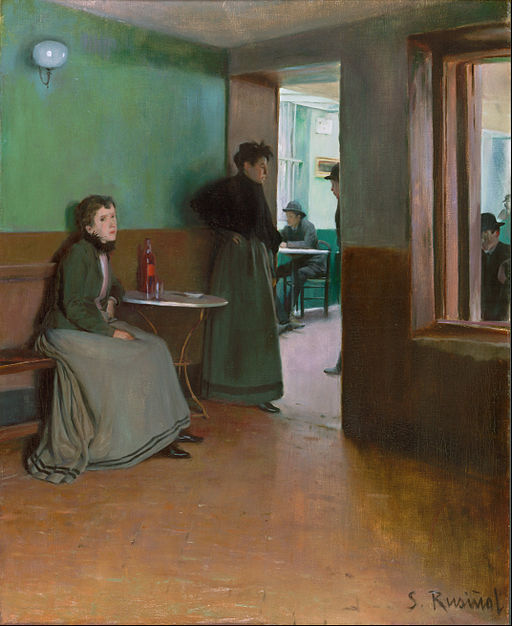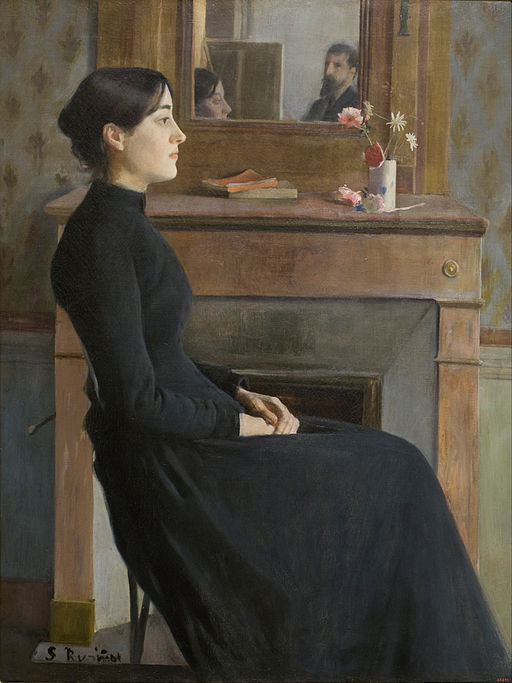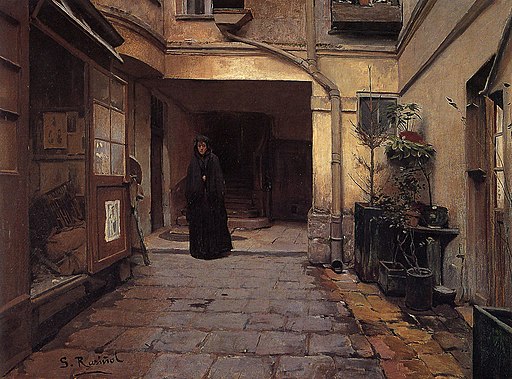
Aranjuez Garden. Arbor, II, 1907
Born on 25th of February, 1861 in Barcelona, Santiago Rusiñol was a Spanish painter and poet. A master of color harmony with a fondness for lush greenery and thoughtful observation of figures, Rusiñol is like one of those fine wines you wish you had discovered sooner. He is unique in how he seems to effortlessly oscillate between Realism and Impressionism without missing a beat, and yet what ties his work together is his supreme understanding of mood and presence. Having trained under Tomás Moragas, Rusiñol evolved into his modernisme movement and leaving a deep impression on Pablo Picasso, among others.
In the garden of Aranjuez Garden Arbor, II above, Rusiñol's very warm earth palette is enthralling. Although loosely painted in the foliage and trees we can instantly sense the verdant beauty of this wonderful park south of Madrid, still enjoyed today by Spaniards and tourists. The yellow and red trees off to the left appear as if on fire, burning with rich tone. Rusiñol places the statue of the faun near center yet it does not detract from the embrace of the greenery surrounding it. The distant trees have an interesting range of greens with more warm tones behind them, which breaks up the monotony of tone. Yet it is the deep gray sky above, hidden by the trees around it, which creates the mood for quiet appreciation of nature.

Interior of a Café, 1892
Love this painting. Seamless combination of Impressionism and Naturalism. Using a green monotone palette and making it work so well here is evidence of a true master of the brush. Both women have green skirts yet in totally different tonality. The woman seated on the left is scumbled in a gray-green, while the woman standing in a vibrant, darker shade that matches the seated woman's jacket. Rumpled drapery is never easy to paint yet here, Rusiñol makes it look effortless and natural. The wall above them is another shade of green entirely scumbled with yellow and yet it blends easily into the color scheme. Notice how he continues that grey tone across the corner of the ceiling. The door frame curiously has tints of violet into the greens to indicate shadow, continuing the violet along the light of the window pane. These are colors that no artist would consciously mix on a palette yet in doing so, Rusiñol easily weaves light and shadow for our very eyes. The greens in the next room are very bright and warm yet balance smoothly with very pale walls above them. Rusiñol balances the main interior with a range of oranges and yellows, hints of that violet tone in some areas, and greyed down to create the shimmer of a shiny floor. That bottle of wine on the table adds a certain magic to this composition, an object that has a character of its very own. Rusiñol's facial expressions here are what tie the whole painting together and make this peaceful interior a pleasure to observe and reveals Rusiñol at the height of his skills.

Crepuscle Île Saint-Louis, 1890
This is like a dream. Minimalist yet conveying all the texture and light of nature on an early winter morning. Located in central Paris, Île Saint-Louis is today a trendy pedestrian destination but here, in the stillness, Rusiñol conjures the warm glow in the eastern sky with cool blue and magenta tones in the shadows. The bridge and far right buildings have a desaturated greenish gray that contrasts with the magenta in the trees on the far right. Yet the way Rusiñol paints the shimmering reflection on the Seine with an seamless arrangement of yellows, blues, greens, and whites is breathtaking. A few minutes soaking in this scene and you forget that this is a painting. With minimal details. And yet we feel like we are there, tightening the scarf around our necks with hands in our pockets...looking out at this simple poem. A triumph of color and mood.

A Romance, 1894
The narrative is crystal clear, and yet we are intrigued enough to look deep within the scene. The music teacher is in love with this lovely woman playing the piano, who gazes at a sheet of music with incoherent, half-empty notes as if to suggest the emotions being more important than the music itself. The piano itself is painted very warm brown tones that fade into dry brush off the bottom of the composition. I like the way Rusiñol paints the sleeve of her dress with violet shadows into the red. And the way her bright red dress, like a cadmium red, contrasts with the tints of green against the wall behind her. The dark, warm greens behind the man are complimentary to the red dress and seem to suggest a relationship of contrasts between the man and woman, especially by her cool, collected playing with no emotion. Rusiñol's narrative tells us that opposites attract here, in every sense of the word and that the suggestion of details is enough to convey the information needed for this love story.

Alley of Rouen, ca. 1900's
Beautiful brushwork in this simple yet dramatic corner in Northern France. This is the kind of painting that makes me want to grab my brushes and paint immediately on a canvas. Rusiñol conveys texture with both smooth and scumbled brush strokes while also dancing around the color wheel effortlessly. Compare the wall on the right with those muted, orange-yellows and see how that contrasts with the central wall and its vertical, green strokes. He then scumbles grayed greens and warm tones on both buildings to indicate the worn, aged look of this neglected alley. The brick wall on the far left breaks up the monotony and helps lead our eye toward the center where another street lies behind the alley and two indistinct figures are suggested for scale. The road itself in the foreground has long strokes of yellow ochre, greys and tints of green while even revealing parts of the underpainting itself yet it seamlessly conveys the texture of a road. These colours would look muddy and incoherent mixed on a palette but here, on this old road, Rusiñol leads our eye to a quiet corner with character and personality, inviting us to stay and look for a while, as all great art does.

Boats on the Seine, 1894
Rusiñol's confidence reigns high in a meditative poem here conveyed with soothing contrasts of atmosphere and intensity. The faded buildings off into perspective are indicated in cool greys that are glazed atop of a hazy overcast sky. His foreground trees and boats are painted in distinct, thick brushwork, also in perspective, yet the greens in that reflection of the boats is sheer magic. And the way he paints thin, violet strokes within that warm water reflecting the hazy sky above...this is what painting is all about. Pure poetry.

Female Figure, 1894
The stark simplicity of this pose is strangely hypnotic. A woman in a black dress seated in profile is nothing extraordinary but somehow, once again, Rusiñol enthralls us. She has the same kind of calm peace that the piano player does in the previous painting, with her hands in lap but the difference here is a reflection of Rusiñol in the mirror where we see the back of the canvas and the woman's reflection. The book and flowers suggests a woman of intelligence and refined tastes, but nothing more. We have no idea who she is yet we are intrigued. The way she is gazing out the window into the distance seems to suggest she has probably never posed for an artist before, unsure of what to do yet relaxed nonetheless yet her reflection in the mirror hints at a different side to her personality, bearing little resemblance to the woman before us. Was Rusiñol channeling Velázquez? Perhaps.

Interior, 1891
I love the quiet drama in this scene. What is happening here? Did they have an argument? She seems angry or ignoring the man who just opened the door and peered in. This contrast of movement between a seated figure and a man standing by an open door is very well done, conveyed like a scene from a movie. This dimly-lit warm interior appears to be a character in the narrative itself, with warm wood doors and those unusual hues in the ceiling and floor that make Rusiñol what he is. The pair of umbrellas by the chair in the corner suggest they have just come back from a stroll somewhere or are about to leave for one. The way she is dressed also, in traditional spanish attire contrasts with his distinguished grey suit. This could be a genre in itself, it is so subtly conveyed and despite its mystery is so well composed.

Casa de empeños, 1889
This is Rusiñol's textural genius at work. Stone, wood, concrete, metal and flora. That warm glow against the wall adds so much life to an ordinary scene, and Rusiñol cleverly uses complementary yellow and violet tones in a way that draws us into the painting. The title of this work translates to pawnshop in english, which would explain the uncomfortable presence of this woman who doesn't seem very impressed by the wares of this place. Like all of Rusiñol's work the setting itself is a character in the scene, and his unique ability to convey the age and weathered look with his genius brushstrokes is what separates Rusiñol from many other of his contemporaries. Rusiñol reminds us that although the figures and the narrative are always important, the background, the setting itself is the painting.

The kitchens, Moulin de la Galette, ca. 1900's
A gorgeous, low-key composition full of light, texture, colour and perspective. Nothing is happening here except an old woman is seated on the steps of this vacant outdoor kitchen, yet visually this composition is firing off on all cylinders. Look at the lines of the beams in the overhang leading outside in perspective glowing with warm light, and how this contrasts visually with the horizontal lines of the stairs themselves, then the kitchen overhang has lines going in another direction. Rusiñol frames this woman in a dark beam with a window off to her side, then contrasts this with a bright yet overcast day filled with trees and that quirky earthtone ground of Rusiñol. Yet the interior of this kitchen reforces Rusiñol's love of rich, warm tones from deep yellows to dark browns. That vertical rise of steam on the far right side of the composition adds depth and meaning to the scene. Looking within the kitchen itself we can make out utensils hanging on the wall and another window using again different set of lines for visual interest. This is a compositional masterpiece.

Santiago Rusiñol, photograph by Kaulak, 1906
Rusiñol is a painter of the highest order and worthy of considerable study, both as an observer of his time and as a poet who crafts mystery in the ordinary under his very astute eye.
Comments
Post a Comment